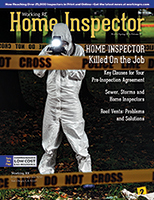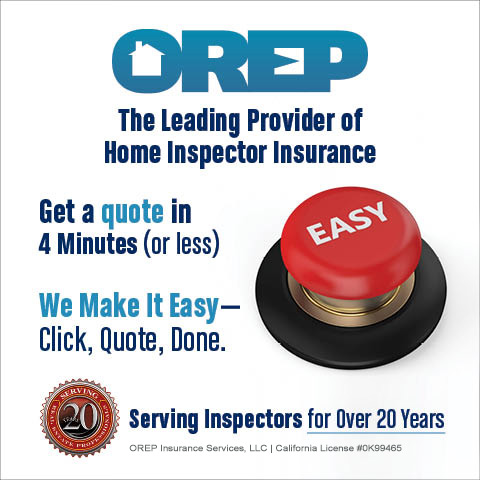 | > E&O/GL Insurance for Home Inspectors Competitive Rates, Broad Coverage, Free Risk Management, online inspection support for tough questions, discounts on education and more... Professional Coverage, Competitive Pricing Shop OREP today! |
>> Editor’s Note: To help you stay up-to-date and connected, OREP/Working RE has established a Coronavirus (COVID-19) Discussion and Resource Page where you can share your thoughts, experiences, advice and challenges with fellow inspectors. See what Inspectors are saying here!
“But let me be clear on this: proper roof ventilation does not prevent ice dams. It just nudges you in the right direction. The same thing goes for frost in the attic; proper ventilation may reduce frost accumulation in attics, but it won’t prevent it.”
Roof Vents: Problems and Solutions
By Reuben Saltzman, Structure Tech
Back when I first started doing home inspections, I was under the impression that roof ventilation was the cure-all for everything. I would look at a lot of problems and was quick to point to insufficient roof ventilation as the cause, then I would recommend more roof ventilation as the cure.
Blistered shingles? Not enough roof ventilation.
Ice dams? Not enough roof ventilation.
Frost in the attic? Not enough roof ventilation.
Today, I’m much more ho-hum on roof ventilation. Asphalt shingle manufacturers require roof ventilation to help preserve the life of shingles, despite the fact that the color of shingles will have a greater effect on their life expectancy than roof ventilation will. Here’s an excerpt from Joseph Lstiburek’s article Info-015: Top Ten Dumb Things to Do in the South:
Let’s now talk about durability of shingles and shingle temperature. Venting or non-venting a roof has about a 5 percent impact on shingle temperature and roof sheathing temperature and even less on shingle durability. The color of the shingle is more important than venting or non-venting.
An attic with insufficient ventilation will get warmer than a well-ventilated attic, which may increase the temperature of the shingles. And it may decrease the life of the shingles…just a little. Proper ventilation will also help keep the attic space cooler during the winter, which reduces the potential for ice dams. But let me be clear on this: proper roof ventilation does not prevent ice dams. It just nudges you in the right direction. The same thing goes for frost in the attic; proper ventilation may reduce frost accumulation in attics, but it won’t prevent it.
In other words, roof ventilation isn’t a cure for any condition, but it’s still required. Roof vent manufacturers publish installation instructions that are easy to read and should be easy to follow, and roof ventilation is required in section R806 of the building code, but a lot of folks either don’t read the instructions or don’t understand them. Today I’ll cover some of the most common roof vent installation issues we come across as home inspectors.


Mixed Exhaust Vents
For proper ventilation, both high and low vents need to be installed. On paper, high vents are supposed to act as exhaust vents while low vents should act as intake vents. Convection is supposed to make this happen. In reality, it all depends on how the wind blows; convection has little to no effect, and it’s never perfect. The intake vents will typically be soffit vents, while the exhaust vents may consist of ridge vents, turbine vents, box vents, or powered vents…but only one of those. (See Figure 1: Different types of vents), all installed on the same roof, which is a “no-no.”
When different types of roof vents are installed, there is an increased potential for air in the attic to short-circuit. In Figure 1, the power vent would probably end up sucking in air from all of the other high vents in the photo, while pulling in just a small amount of air from the lower soffit vents. The solution here is to install only one type of exhaust vent.
(story continues below)

Power Vents
Power vents shouldn’t be used because they create more problems than they fix. I blogged about them many years ago: Attic Fans Won’t Fix Ice Dams (or anything else). I use the terms ‘attic fan’ and ‘powered roof vent’ interchangeably, as well as ‘roof vent’ and ‘attic vent.’
Crooked Turbine Vents
I’ve never been a huge fan of turbine vents because I have it in my head that they may end up causing some of the same problems that powered roof vents do, but the fine folks at Complete Building Solutions swear by them, and I trust those guys, so I won’t complain about turbine vents. But, the one thing I will mention is turbine vents need to be installed perfectly level; when they’re not installed level, they won’t turn. In Figure 2: Turbine Vents, you can see that the vent on the left wasn’t level. Do you see anything else that’s wrong in the photo?
Turbine vents really do pull air out of the attic. If air sealing hasn’t been performed in the attic, turbine vents will pull air into the attic from inside the house, and shouldn’t be used. That bears repeating: do not install turbine vents if the attic has not been professionally air-sealed.


Insufficient Intake Vents
Current standards specify a 50/50 split between high vents and low vents, but how are low vents supposed to be installed in a house with no soffits? See Figure 3: Roof with No Soffit for an example.
Without any low vents, the high vents will tend to pull conditioned house air into the attic through air leaks. One solution would be to install special vents cut low into the roof, such as SmartVents™. (See Figure 4: SmartVent Example).
Another less desirable option would be to install a bunch of box vents low down on the roof. I could go on and on with these roof vent installation errors or shortcomings, but I never make a huge deal about it because I don’t think it makes a difference.
Focus on sealing attic bypasses before addressing ventilation. Ventilation mostly helps to hide other problems. For more reading material on roof ventilation, visit WorkingRE.com/roofvents for a list of articles I recommend.
About the Author
Reuben Saltzman is a second-generation home inspector with a passion for his work, and is the owner and president of Structure Tech. Visit his blog online at: https://www.structuretech.com/blog/.
OREP/WRE Coronavirus Discussion and Resource Page
Coronavirus: National Home Inspector Survey
Real-Life Inspector Lawsuits and How to Protect Yourself
Available Now
Presenter: Isaac Peck, President of OREP
Isaac Peck, President of OREP Insurance Services, shares his insights and advice gained over nearly 10 years of providing risk management and E&O insurance for home inspectors. You will not hear many of these insights anywhere else.
Watch Now!
Send your story submission/idea to the Editor:
isaac@orep.org
Note: The Winter/Spring 2022 Working RE Home Inspector is now mailing to over 25,000 home inspectors nationwide. OREP Insureds/members enjoy guaranteed delivery of each print magazine and many more benefits.



by Rodney cox
I love the Home Inspector Magazine! Love the article’s. They are so informative.
-